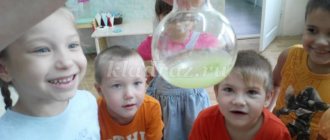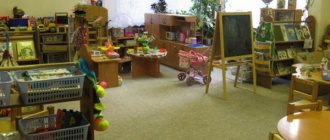What is a mixed age group
This is a group in which children differ from each other in age and development. Most often, such groups are taught in kindergartens. To create a multi-age group, it is not enough to simply gather children from 3 to 7 years old in one place. The group requires a special educational program: children study the same material, but older ones study at an in-depth level. Teachers also delegate some of the household and pedagogical tasks to the older children: the elders help the younger ones get dressed, put away the dishes, and explain tasks. Most often, multi-age education is used in kindergartens working according to the Montessori approach or within the framework of Waldorf pedagogy.
I'll add a few more words...
My friend’s son ended up through an acquaintance in a kindergarten for children with visual impairments, because it was more convenient for them. The boy was used to seeing children with glasses, squints, and poor vision. And when he got into a class where there was only one boy with glasses, he could not understand why they were laughing at him, because he simply had trouble seeing...
Remember, in our Soviet childhood, at school they teased everyone who was at least in some way different from the masses: bespectacled, lop-eared, too light-skinned, and vice versa - dark-skinned, plump and thin. To be like everyone else was considered commendable. Today, the humanity of society has nevertheless increased, it seems to me. There is much less teasing in children's groups and fewer offensive nicknames are given.
What are the pros and cons of different age groups?
Accelerated development
. In a mixed-age group, younger and older children help each other communicate and learn. The younger ones develop faster, catching up with the older ones. The elders learn responsibility, and also “consolidate” knowledge and skills by helping the younger ones in everyday life and with tasks.
Model of society.
A group of children of different ages more closely resembles the real world - a child already in kindergarten understands the principles of communication in real life.
Development of emotional intelligence
. In such groups, children see a huge range of emotional reactions: some are upset because of the absence of their mother, others are happy about their first victories. Children learn to empathize and develop empathy. Many gain experience of communicating with peers other than their peers, which an only child in the family cannot get.
Minimum conflicts
. Peers may have more conflicts than children of different ages. In addition, children of different ages react differently in conflict: if a three-year-old is stubborn and does not share the toy, then a six-year-old will give in to the younger one or offer another way that will suit everyone.
Difficulties in adaptation
. In groups of different ages, it is more difficult for newcomers than in groups of peers. In such groups, some of the children leave the kindergarten, and new ones arrive at the beginning of the school year. They have to integrate into the existing structure of the group and much depends not on the children themselves, but on the attention of the teachers.
Little attention from teachers
. Some educators may place too much responsibility on older children and not pay enough attention to younger ones. Or, on the contrary, pay attention only to the younger ones, thinking that the older ones will cope on their own.
Indications for placing a baby in a combined group
If you yourself want your child with special needs to be raised and educated in a combined group, and there is one in the kindergarten, then you submit an application for admission addressed to the head. In addition, you need to bring various documents:
- Birth certificate or copy;
- Conclusions of doctors: ophthalmologist, speech therapist, neurologist, otolaryngologist, orthopedist;
- Extract from the history of the child's development;
- Recommendation from a teacher-psychologist or speech therapist at a preschool institution, if the child is already attending kindergarten.
Next, you will need to take a referral and go through a special commission, which gives an opinion on the child’s possibility of attending such a group. Usually, the Regulations on the combined group of a particular kindergarten prescribe the conditions for admitting children to this group.
Since the occupancy rate in preschool educational institutions in most regions of our country is now high, there is a practice of placing a child on a waiting list for admission to kindergarten. Therefore, I advise you to take care of collecting all kinds of certificates, etc. in advance. I know that some kindergartens have opened electronic registration for the queue. So don't leave this question to the deadline.
I also wanted to raise such a sensitive issue as the negative attitude of some parents of healthy children towards raising them together with children with disabilities. Yes, it happens that mothers directly rebel against the combined group, believing that it can harm their child.
I would like to say the following: according to the experience of my colleagues who have been working in combined groups for a long time, both sides benefit. Healthy kids, brought up in the same team with special children, become more sensitive, kind and tolerant of the shortcomings of other people. They are accustomed to perceiving their comrades with disabilities as their equals, not paying attention to any features of appearance and health.
The number of children with developmental and physical disabilities is growing every year. Therefore, the task of a civilized society is to provide such people with an equal position in all spheres of life.
How to organize work in groups of different ages
Maintain age symmetry
. Mixed-age groups work effectively if they include peers for everyone. Ideally, there should be an equal number of children of each age in the group. This rarely happens in practice, but it is important that one six-year-old does not study in a group with three-year-olds. Such a group would not be considered truly diverse in age. Balance helps everyone find communication partners.
Arrange the environment
. Children of different ages have different play and learning needs. Therefore, it is important to create a developmental environment that suits everyone. The Reggio or Montessori approach is best suited for these tasks. It is zoned and children can go in small groups or individually to different corners. In the common area they can communicate with each other and play group games.
Experiment with the mode
. Most often, the daily routine suits all preschoolers at once, but the younger and older ones may not agree on small details. Younger children need a little more time to sleep, so older ones may need to be woken up later. Also, younger children need more time to dress and eat.
Learn to work in small groups
. Moreover, it is advisable to constantly change the composition of these groups, adhering to only one rule: each group should contain children of different ages. Working in small groups helps children communicate effectively. Also, in microgroups, older children better convey their experience to the younger ones.
Use rituals
. Although small group activities are effective, preschoolers should not forget that they are a group. Rituals help with this: a common circle at the end of the day, a password that must be said to enter the group, chants on the way to your site. Almost anything can be a ritual: for example, you can read fairy tales before bed, which the children choose in turn.
Pay attention to everyone
. You cannot shift responsibility to older children. It is important that everyone, both junior and senior, receives care from the teacher. Otherwise, older children gradually take on responsibility and demand power commensurate with it.
Seminar for teachers “Organization of work in a mixed-age group”
State government institution of social protection of the Krasnodar Territory "Apsheron Social Rehabilitation Center for Minors"
Organization of children's lives and activities
in a mixed age group.
Reception teacher
with the quarantine block N.S. Kravchenko
2017
1. “Morning Sun” greeting ritual
.
Music is playing. With music in the background: A new day has come. I smile at you and you will smile at each other. And think about what surprised or pleased you today. We are all healthy. Inhale deeply and as you exhale, forgive each other’s grievances and worries. Breathe into yourself the freshness and beauty of white snow, the light and warmth of the sun's rays. And my surprise was caused by the sun. It turns out that it is like a real wizard, it knows how to greet warmly and affectionately. What do you dream about when looking at the sun? (Answers). Now I suggest you make the sun yourself. Yes, something that will warm your soul and lift your spirits. Those present begin to draw “THE SUN”. (Video 1)
Now that everyone has finished their work, look at our sun. It's like it's gotten lighter! Close your eyes. Stretch out your hands to the sun. The generous rays of the sun, like gentle hands, hug, stroke, and warm us with their warmth. There is peace and grace in the soul. We want to laugh and enjoy the new day. The magical sun melted all the grievances, sadness, sadness. It has accumulated our heart with kindness and love. Thank you, let's get started!
2.
Statement of the topic of the seminar.
The specificity of our work is that the age composition of children in the institution is constantly changing, and there are no clear boundaries of age groups, which is the complexity of the educational and social rehabilitation process as a whole. (Video2)
The topic of our seminar: “ Organizing the life and activities of children in a mixed-age group.”
3.
The content of the teacher’s activities in a mixed-age group.
On the one hand, in such groups a favorable environment is created for the development of the personality of both older and younger children. In this case, a group of different ages is formed according to the model of a large friendly family, where there is responsibility and initiative of the elders and the ever-increasing independence of the younger ones. On the other hand, different ages of children activate specific difficulties and problems, and first of all this is the organization of classes. In a same-age group, the teacher, preparing for classes, relies on content designed for a certain age. In a multi-age group, he combines the requirements of the program content for two or more ages. This requires additional effort from the teacher. During classes, the teacher
must in a unique way connect the different contents of the lesson material according to the capabilities of the children, quickly switch their attention from one age subgroup to another. Hence the specific task
: organize joint activities of children of different ages, highlight in advance for the older ones some aspects that correspond to their level of development, characteristic preferences, for the younger ones - others, in accordance with their interests and capabilities.
A teacher in a mixed-age group uses various types of activities, and he must take into account both the methods of organization and the nature of the distribution of functions.
In a group of different ages, knowledge and skills are constantly transferred from older to younger. Children follow their elders, learn from them, adopt rules of behavior, ways of resolving conflicts, and also, of course, want to repeat what their elders do - for example, they are interested in more complex material.
The influence of a different age group on the characters of children is interesting. A timid child, interacting with kids, can develop leadership qualities; his own authority rises in his eyes when he leads younger children or helps them do something.
Thus, a mixed-age group provides many opportunities for children’s personal and intellectual growth, socialization, and learning. This requires more subtle work by the teacher, the ability to observe, to say something at the right time, or, conversely, to remain silent, giving the children the opportunity to figure it out for themselves. It is also important to properly organize the environment so that it meets the needs of children of all ages. Therefore, when organizing work in a mixed-age group, the following points must be taken into account:
1. The teacher must clearly define the purpose, objectives, and content of the classes.
2. In frontal lessons, it is better to solve more general problems, and more specific (different) ones - in lessons with one subgroup of children.
3. The main form of work remains classes (complex, combined, general). When conducting complex classes, it is necessary to ensure that the activities of children in one subgroup do not distract children from another subgroup. It is advisable to conduct general classes provided that the topic is the same or similar for children of all age subgroups, taking into account the children’s capabilities and level of independence.
4. The material prepared for the lesson must contain common elements for children of all subgroups, which makes it possible to unite students to play games and perform certain tasks.
5. Completing tasks in a mixed-age group is carried out in two ways: under the direct supervision of a teacher; with the help of didactic games and didactic materials (children’s independent work).
6. When organizing the educational process, it is necessary to take into account the individual, age and gender characteristics of children. (Information about age requirements in the booklet).
In groups of different ages, frontal, group and individual forms of organizing classes are used, which allow different ways to form the relationship between the teacher and children and children among themselves. For example: teamwork
(panel, applique): the older children, the organizers and the main performers, draw up a pattern, cut out complex shapes, fasten the parts, and the younger ones, their assistants, trace a simple contour according to the template, smear the parts with glue, and hand over the tools. The teacher draws the children's attention to the positive qualities of both older and younger friends, encourages any attempt to help, protect, teach the younger one. And the younger ones, imitating the older ones, learn to carry out the task diligently and overcome difficulties.
The situation is simpler with activity
. In this activity, children of every age can demonstrate their abilities to the fullest. So, for example, in thematic drawing (“Seasons”), older children perform more complex drawings - an autumn forest, and younger children, accordingly, autumn leaves.
Role-playing games
. One option is for the older ones to play more responsible roles (teachers, sellers, drivers, etc.), and the younger ones to act as subordinates (students, buyers, passengers). In order to avoid manifestations of selfishness, it is advisable to change the roles and positions of the participants (the second option is the other way around), when the work is led by the kids, and the elders are the executors of the plan.
Team games
. Here, great opportunities open up for the realization of the abilities of all participants and the opportunity to express themselves within the same age subgroup, because When conducting team games (educational, sports, entertainment), the teacher takes into account (when selecting tasks) the age characteristics of the children, as well as their potential abilities. Therefore, along with intellectual tasks, there should be tasks of a creative nature (complete the drawing, come up with a story, pantomime). A good educational effect is provided by the inclusion of joke tasks and fun tasks in a team game. Funny situations, funny actions of seniors and juniors bring the participants closer together, contribute to the manifestation of deeper interest in each other, positive emotions, and empathy.
Dramatizations
. They are used both as an independent activity and as a task, for example, in a team game. Here, the distribution of roles also takes into account the age and abilities of the children. The teacher positively reinforces the actions and actions of the elders, drawing the attention of the younger ones to them. And praise for the younger ones and care for them will increasingly orient the older child towards the younger partner. The joint participation of children in one or another activity promotes mutual understanding, develops skills, and unites.
Entertainment, concert, performances
. You can prepare both for little ones with the help of older children, and for older ones with the help of younger ones. This form of work brings people together very much, especially if it coincides with a birthday. Children of any age are happy to participate in the preparation of the holiday, because... everyone can submit a program number in accordance with their capabilities, interests, and talents.
In addition to specially organized classes, a qualified teacher can and should use a variety of situations that arise in the process of interaction between children (in other classes, in a game, on a walk, when organizing meals...) in order to enrich and develop the social competence of children. This purpose can also be served by organizing general events at the level of the entire institution, such as holidays, classes in studios, and clubs. A variety of organizational forms will contribute to a significant expansion of the range of communication between children and adults, will allow teachers to better understand the feelings and experiences of children, and support them in different situations.
However, it must be borne in mind that a child gains a positive experience only if the preparation of the event, the organization of activities and games are structured in such a way that the children feel the need for each other and understand the meaning of mutual assistance.
Adults should not consider possible conflict situations as something negative or unpleasant. They should be used constructively, as an exercise for children to acquire the ability to solve such problems. It is important to support in children a sense of community, a desire to cooperate, and to strive for them to play not only with those they like and with whom they are friends.
The teacher must constantly carefully monitor the emotional state of the children; differentiate program material, dividing it into that which is given frontally and that which needs to be explained to a small subgroup or individually.
4. Features of conducting classes in a group of different ages.
When working in a group of different ages, the teacher must take into account the thinking characteristics and level of development of instrumental skills of children of different ages. When conducting a lesson in a group of different ages, you should pay attention to the following points.
- Formation of an interested attitude towards the overall result. Children should know why the work is being done and what the benefits of working together are.
- Forming in children the ability to act together and coordinate their actions. This teaches children to work in a team, join forces, subordinate personal interests to common goals, teaches children to negotiate, and look for ways to resolve conflicts that arise.
- Analysis of the overall result and personal contribution of each participant.
- An important point is the teacher’s ability to regulate the duration of classes for children of different ages. Here it is possible to work with a subgroup or individually during one lesson.
The atmosphere of cooperation and mutual understanding in the children's environment plays a huge role. The unity of the topic of the lesson makes it possible to create a unified emotional mood. Some children (younger) learn the information received in class for the first time, while older children clarify and supplement it, consolidating their knowledge. Such activities allow each child to solve a feasible problem.
Often, when working with children of different ages, complex classes are held, where older and “experienced” children help in preparing for the lesson, and in the course of working together, older children take on the role of a consultant. Educators often use such a technique as dividing operations, when pupils of different ages perform one voluminous, labor-intensive work, while younger children often work with templates and ready-made forms. For example, the “Bird Yard” activity is complex. During the lesson, the youngest children depict an egg, the middle ones - a chicken, the older ones - a rooster and hen, and also complete the design of the entire work.
Another option for organizing children in the classroom is to work in a “senior-junior” pair, where children perform certain tasks, distributing the work among themselves. Creative works, applications, origami, etc. are carried out in a similar way. Older children additionally show younger ones how to perform this or that task, explain and control the actions of the younger one. The younger child, in turn, uses the work of the older one as a step-by-step model and borrows methods and techniques of work.
The activity of the older child in relation to the younger one has a serious educational effect, forming in the “mentor” a sense of responsibility and involvement in the work of the younger one.
In order to rationally structure the pedagogical process, it is necessary to determine the composition of the group in each specific case, identify two or three subgroups and, in accordance with them, differentiate educational work.
Depending on the age composition and number of children, the placement of children in groups and subgroups may be as follows:
Option 1. Dividing groups into subgroups: 1 – younger age,
2 – older age.
Option 2. Group 1 – older children of the same age.
2 groups - younger children
and vice versa.
Option 3. Groups of children of sharply contrasting ages (for example, 3-5 years old and 10-12 years old).
Differentiated work with two or three subgroups is feasible for every educator and, at the same time, can significantly improve the quality of education and training, especially for older children.
5.
Formation of everyday skills through communication in a group of different ages.
The formation of everyday skills and abilities of children in a multi-age group requires great skill of the teacher, clarity and coordination of the work of all service personnel, the creation of a calm and friendly environment, and attentive attitude of adults towards all children, especially the younger ones. In the process of daily activities, children should develop habits of correct behavior in a team and friendly relationships.
Household skills include:
- bed cleaning;
- clothing care;
- cleaning of premises.
Communication between older and younger children in the process of developing everyday skills is extremely important for the personal development of both. Teachers working in a mixed-age group should ensure that the work of the older friend is a model for the child. Therefore, the teacher must foresee what children can imitate and what they can teach each other. Older children can pass on their experience in the field of self-service, household and hygiene skills to younger ones. The main condition for this is their joint activities to carry out various assignments and responsibilities.
In a mixed age group, assignments can take place throughout the day. Some of them are caused by everyday life needs (preparing for classes, eating, sleeping, cleaning the premises), others are specially organized by the teacher in order to form or strengthen relationships in children, the ability to cooperate, and have a completely pedagogical orientation. Assignments should be given to all children, but taking into account age characteristics and individual capabilities. It is important to determine the share of participation of each child in completing a common task, to help him show independence in joint activities with other children.
Experience shows that older children cope well with the assigned work in the area allocated to them, but younger children experience difficulties (they cannot work for a long time in one area, they are often distracted and move to another area of work). They can watch the work of their elders, be their assistants: go rinse a dust cloth, take garbage to a bin, serve trays from flower pots, wipe dust in a small area, etc. However, cleaning as an independent task is beyond their strength. Young children are involved in joint activities with their elders, carrying out a feasible part of the common task.
Regardless of age, during the day each child must complete some assignment that contributes to the formation of everyday skills: put a forgotten thing or toy in its place; put a chair, remove it, move it; provide the required item, etc. The teacher can instruct the older child to do this together with the baby.
The most educationally effective form of developing everyday skills through communication in a group of different ages is a request or proposal, and certainly with a justification for why it needs to be done. For example, “Ruslan, do you want to help Polya put away the toys? Otherwise it’s a mess and very uncomfortable.” The teacher can motivate the need for help by saying that younger comrades need to be taught what the elders themselves can do quickly and deftly.
In the process of developing everyday skills, the teacher must be close to the children. During the work process, it is necessary that children constantly feel the teacher’s interest, his attention to what they are doing. Experience shows that children are not at all indifferent to where the teacher is: busy with something else or closely watching them. The younger children themselves say that they would like the teacher to watch how they work.
However, the teacher should not consider older children only as his assistants and assign part of his responsibilities for caring for the younger ones to them, since the older ones have less time for independent activities, and the younger ones develop a dependent attitude towards others. Older and younger children may develop mutual sympathies. The little ones choose their “mom” or “dad” from the older children. On the basis of such mutual communication, everyday skills are formed more quickly.
6
.
Relationships between children in different age groups.
Full interpersonal relationships between students are the key to harmonious personal development and valuable social experience in communicating with people. The formation of such relationships is influenced by age, length of stay and reasons for entering the institution, as well as the personal qualities of children.
In our work with children we encounter the following manifestations of antisocial behavior:
- show physical aggression from slaps to fights,
- take away or try to take away food,
- shift their responsibilities to younger ones,
- show verbal aggression
- demonstrate rejection of one another in games, activities, conversations,
- persuade the younger ones to run away (for company).
Sometimes the reason for this behavior lies in the social infantilism of adolescents, which gives rise to envy of younger children.
When organizing the interaction of children of different ages, educators are guided by the following requirements:
- Ensuring integration and differentiation of social interests of adolescents in the activities of different age groups. This is taking into account personal and group interests in the joint activities of children. The basis for successful joint activities of seniors and juniors is a common interest, a necessary and useful business for everyone, in which everyone will find a personally significant and attractive side for themselves.
- Concern for updating the content and forms of joint activities of children of different ages, which stimulates the voluntary inclusion of children in all spheres of social relations.
- Development of cooperative relationships between children on the basis of mutual support, mutual assistance, ensuring the security of each child, caring for equal relations between children, regardless of the age and social role of the pupil.
- Work on self-development and self-organization of life activities of groups of children of different ages. This is the voluntary association of children, providing the opportunity to decide on their own issues of organizing life activities, stimulating initiative, creativity, amateur performances of children, and developing self-government in a group of different ages.
Contacts between children of different ages stimulate collective creative activities and games, which can be organized by older students. It is important that seniors are able to establish cooperative relationships with juniors. This is achieved by special training of child organizers and pedagogical regulation of their interaction with other children.
A special problem is the organization of intergender interaction. The work of teachers is aimed at overcoming typical negative manifestations in intergender communication:
- the formation of violent same-sex gangs,
- inability to build intersexual communication,
- lack of youthful romanticism,
- rejection of moral norms of relationships,
- early onset of sexual activity in girls.
In order to develop readiness for adequate social and interpersonal relationships among students, educators work in the following areas:
- “Life position” is the development of the emotional, volitional and motivational sphere.
- “Life resilience” - preparing for life’s difficulties
- “Behavior correction” is the work of social educators to develop a moral position.
- “Psychological assistance” - individual and group correction.
In the interaction of children of different ages, there is such a feature that younger children feel the need for joint activities with older children, the desire to directly participate in their games and life. In a sense, older children begin to act as models for younger ones.
Good relationships between children in a mixed-age group form the basis for a child’s experience of emotional well-being. Disapproval and refusal of contacts are perceived extremely difficult by younger children. Therefore, the child strives to act in accordance with the behavior of an older adult and gradually assimilates the norms, rules and assessments that come from them. It is very important to constantly monitor and correct the behavior of teenagers so that younger children do not adopt the negative, negative experience that most of our teenagers have.
It is necessary to give children with such life experience as much positive information as possible, through reading fiction aloud, examples from the lives of teachers, conversations with guests of various professions, etc.
"Piano"
Goal: Team unity, building trust and
goodwill relationships.
Progress of the game: hands are placed on the neighbors’ knees. Playing the piano begins in a circle; the children hit their knees. The one who gets confused removes his hand.
Gradually, following the rules and observing norms of behavior, thanks to the constant connection with positive emotional experiences, begins to be perceived by the child as something positive in itself, appearing in a generalized form, which can be denoted by the word “ need
" This is the moral authority that the teenager begins to be guided by and which acts for him not only as knowledge (one must do this), but also as a direct experience of the need to act this way and not otherwise.
7. Communication of children in a different age group
through joint activities.
Specially organized communication has great educational significance. Communication between children in a group of different ages broadens their general horizons, influences the development of the emotional sphere, will, and the ability to evaluate themselves and others. The educational significance of communication also lies in the fact that it is a prerequisite for the formation of a child’s general intelligence. As a result of the interaction of children in a group of different ages in the process of communication, certain stable relationships arise: relationships with each other, relationships with the surrounding reality, relationships with events and facts.
When organizing joint activities of older and younger children, the teacher should first of all strive to evoke a positive emotional response in both. Younger people should enjoy joint activities with older ones, because... they are stronger, they can do a lot, they can come to the rescue. The elders feel a sense of satisfaction from the fact that they already know how to do a lot, can help the kids, and play the role of a teacher.
It is necessary to take into account that older children need to be prepared for joint activities and communication with the little ones, so that the older ones would willingly help the teacher, realize their position as an older comrade, understand what they can do for the little ones, and see the need for joint activities with younger children. Experience shows that without preliminary training for older children to work together with younger children, without identifying the role of each of them, joint communication may not work out. Conflicts may arise that need help to be resolved, using specific examples to explain how to act in a particular case, using advice, tips, and encouragement. There may not be conflicts, but good, friendly relationships will not develop. The children will live nearby, but the younger ones will live on their own and the older ones will live separately. In the worst case, children will act as observers of their elders.
Unfortunately, sometimes one has to observe harsh, even rude behavior of elders towards younger ones, their manifestation of a sense of superiority. It is unacceptable. Younger people often do not even get offended or protest against this style of communication, but obey and fulfill the demands of their elders. If the teacher does not stop such relationships in a timely manner, they may become entrenched.
With children who allow themselves to be rude, individual work is necessary: explanation, persuasion, example of other peers. Each senior pupil is assigned 1-2 junior pupils. It is necessary to evaluate the behavior of a child who is distinguished by friendliness, goodwill, attention to other children, and personal initiative. The manifestation of such a child must be assessed in the presence of other children. For example, “How Christina spoke affectionately to Dasha! Helped her fasten her shoes! Well done!" But sometimes the selective attitude of an older child towards one of the younger children (even a positive one!) can lead to an incorrect attitude towards other children. Older children may become carried away by the role of an adult and cross the boundaries of what is permitted in a relationship. This may manifest itself in the tone of communication, in rudeness when helping the child, etc. It happens that older children’s interest in playing, in some of their own activities, turns out to be stronger than their interest in joint activities with the little ones. Then they are reluctant to carry out the adult’s instructions given to them together with the kids, and sometimes even refuse it. The teacher needs to show delicacy and patience here, explain the importance of completing the task together with the kids, while avoiding negative assessments. It is advisable to resort to demands in cases where explanation and persuasion prove ineffective. “We have to do it. All children work. And you have to work.” Sometimes, when giving a collective assignment, it is advisable to unite children of the same or adjacent age and assign them to an older friend (for example, if the task is to teach a new skill or when it is necessary to introduce younger children to a certain way of doing work.) The older child shows by personal example the skill being developed. He is needed as a role model, explaining the sequence of execution.
It is very important to promptly approve the desire of elders to help younger ones. If a child does not satisfy his need for emotionally comfortable communication with elders and younger ones in the group, then such negative phenomena as increased personal aggression, inability to build relationships, enter into contacts with others, etc. are discovered.
In order for people to understand each other, each person must be able to express and express himself. Any action acquires one or another meaning depending on what it is for another person. Awareness of your individuality and difference from others must be accompanied by the understanding that another person is also an individual, and if you have your own tastes, interests and desires, aspirations, then others have them too. Therefore, children and adolescents, especially in social rehabilitation institutions, must be taught socially adequate forms of self-display and self-expression. It is necessary to show that in some cases you need to be able to limit yourself, taking into account others. This does not mean that it is enough to simply put the child in front of the need to coordinate his behavior and actions with the actions of other children, as adults often do: “Don’t take it away!”, “Don’t interfere,” “You must help!” etc. It is important for adults to understand the driving reasons, motives for children’s actions and their behavior towards others. It is important to gradually teach children to understand why conflicts arise and to “reveal” their causes. Of course, conflict prevention is much more important. This is facilitated by the development of social sensitivity in children, including through the creation of problem situations and the organization of role-playing games in which children can take on different social roles. It is also very important to organize conditions and situations that help children understand the need for each other, the importance of mutual help and friendship. At the same time, adults should fully support and approve of children's socially receptive behavior. "Good animal"
Goal: to promote the unity of the children's team, teach children to understand the feelings of others, provide support and empathy.
Progress of the game: The presenter says in a quiet mysterious voice: “Please stand in a circle and hold hands. We are one big good animal. Let's listen to how it breathes! Now let's breathe together! When you inhale, take a step forward, when you exhale, take a step back. Now, as you inhale, take 2 steps forward, and as you exhale, take 2 steps back. This is how the animal not only breathes, its big, kind heart beats just as clearly and evenly. Knock - step forward, knock - step back, etc. We all take the breath and sound of this animal for ourselves.”
8. Summing up.
The work of a teacher in a mixed-age group is to create, if possible, conditions for each child in which he could try himself in a business, in his chosen role, and achieve success. This helps every child to believe in themselves, develop will, initiative, and gain self-esteem.
It is important to be able to use all the advantages of raising children of different ages - to organize your work in such a way as to teach the elders to take care of the younger ones.
Nowhere are there richer opportunities for implementing such an education system as in a group of different ages. There are many positive things about raising children of different ages together. Constant communication between younger children and older children creates favorable conditions for the formation of friendly relations, caring, and independence. Here the elders help the baby get dressed, tell him fairy tales, protect him from the offender, that is, take care of him. The example of elders for children is of particular importance. Due to their tendency to imitate, younger people gradually adopt all the positive qualities of their elders. Long-term observations prove that in groups of different ages, younger children learn skills much faster, and older children grow up more sensitive, friendly and responsive.
But all this does not happen by itself, but is the result of the daily and painstaking work of the teacher, the correct organization of life and independent activity of children.
Bibliography:
- Varyvdin V.A., Klemantovich I.P. Managing the child welfare system. – M., “Pedagogical Society of Russia”, 2004.
- Children at social risk and their upbringing / Edited by L.M. Shipitsyna. - St. Petersburg, “Rech”, 2003.
- Kasatkina N.A. Educational classes in an extended day group. - Volgograd, 2005.
- Knyazeva O.L., I-YOU-WE: a program for the social-emotional development of preschool children. - M, “Mosaic – Synthesis” 2003.
- UN Convention on the Rights of the Child. – M., “Infra – M”, 2002.
- Kutsakova L.V., Moral and labor education of a preschool child. - M, “Vlados” 2005.
- Methods of educational work / Edited by L.I. Ruvinsky. - M, “Enlightenment” 1989.
- Minskin E.M. Games and entertainment in an extended day group. - M. Education, 1983.
- Mishchenkova L.V. Kaleidoscope of creative activities for primary school - Yaroslavl: Academy of Development., 2005.
- Features of relationships between preschoolers in groups of different ages // “Preschool Education”, 2002, No. 1.
- Organization of the life and activities of children in a mixed-age group of a small kindergarten. Guidelines. — Kostroma, 2003.
12. Teacher and children - conditions of cooperation. // "Children's leisure", 2004,
№ 4 .
13. Extended day at school: Regime and organization of leisure / Ed.
Loseva O.A. - M. Pedagogy, 1991.
14. Tsukerman G.A. School difficulties of prosperous children. – M.,
“Knowledge”, Faculty of Pedagogy, 1989, No. 3.
15. Shchurkova N.E. A collection of motley cases: Methodological material for
working with children. – M.: New School, 1994.








